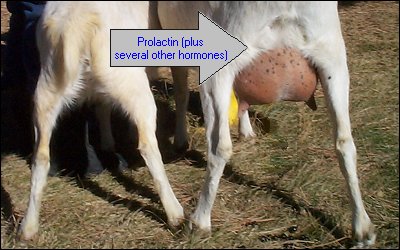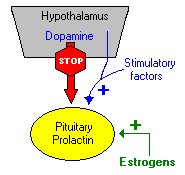VIVO Pathophysiology
Prolactin
Prolactin is a single-chain protein hormone closely related to growth hormone. It is secreted by so-called lactotrophs in the anterior pituitary. It is also synthesized and secreted by a broad range of other cells in the body, most prominently various immune cells, the brain and the decidua of the pregnant uterus.
Prolactin is synthesized as a prohormone. Following cleavage of the signal peptide, the length of the mature hormone is between 194 and 199 amino acids, depending on species. Hormone structure is stabilized by three intramolecular disulfide bonds.
Physiologic Effects of Prolactin
The conventional view of prolactin is that its major target organ is the mammary gland, and stimulating mammary gland development and milk production pretty well define its functions. Such a picture is true as far as goes, but it fails to convey an accurate depiction of this multifunctional hormone.
It is difficult to point to a tissue that does not express prolactin receptors, and although the anterior pituitary is the major source of prolactin, the hormone is synthesized and secreted in many other tissues. Overall, several hundred different actions have been reported for prolactin in various species. Some of its major effects are summarized here.
Mammary Gland Development, Milk Production and Reproduction
In the 1920's it was found that extracts of the pituitary gland, when injected into virgin rabbits, induced milk production. Subsequent research demonstrated that prolactin has two major roles in milk production:
- Prolactin induces lobuloalveolar growth of the mammary gland. Alveoli are the clusters of cells in the mammary gland that actually secrete milk.
- Prolactin stimulates lactogenesis or milk production after giving birth. Prolactin, along with cortisol and insulin, act together to stimulate transcription of the genes that encode milk proteins.

The critical role of prolactin in lactation has been confirmed in mice with targeted deletions in the prolactin gene. Female mice that are heterozygous for the deleted prolactin gene (and produce roughly half the normal amount of prolactin) show failure to lactate after their first pregnancy.
Prolactin also appears important in several non-lactational aspects of reproduction. In some species (rodents, dogs, skunks), prolactin is necessary for maintainance of corpora lutea (ovarian structures that secrete progesterone, the "hormone of pregnancy"). Mice that are homozygous for an inactivated prolactin gene and thus incapable of secreting prolactin are infertile due to defects in ovulation, fertilization, preimplantation development and implantation.
Finally, prolactin appears to have stimulatory effects in some species on reproductive or maternal behaviors such as nest building and retrieval of scattered young.
Effects on Immune Function
The prolactin receptor is widely expressed by immune cells, and some types of lymphocytes synthesize and secrete prolactin. These observations suggest that prolactin may act as an autocrine or paracrine modulator of immune activity. Interestingly, mice with homozygous deletions of the prolactin gene fail to show significant abnormalities in immune responses.
A considerable amount of research is in progress to delineate the role of prolactin in normal and pathologic immune responses. It appears that prolactin has a modulatory role in several aspects of immune function, but is not strictly required for these responses.
Control of Prolactin Secretion

In contrast to what is seen with all the other pituitary hormones, the hypothalamus tonically suppresses prolactin secretion from the pituitary. In other words, there is usually a hypothalamic "brake" set on the lactotroph, and prolactin is secreted only when the brake is released. If the pituitary stalk is cut, prolactin secretion increases, while secretion of all the other pituitary hormones fall dramatically due to loss of hypothalamic releasing hormones.
Dopamine serves as the major prolactin-inhibiting factor or brake on prolactin secretion. Dopamine is secreted into portal blood by hypothalamic neurons, binds to receptors on lactotrophs, and inhibits both the synthesis and secretion of prolactin. Agents and drugs that interfere with dopamine secretion or receptor binding lead to enhanced secretion of prolactin.
In addition to tonic inhibition by dopamine, prolactin secretion is positively regulated by several hormones, including thyroid-releasing hormone, gonadotropin-releasing hormone and vasoactive intestinal polypeptide. Stimulation of the nipples and mammary gland, as occurs during nursing, leads to prolactin release. This effect appears to be due to a spinal reflex arc that causes release of prolactin-stimulating hormones from the hypothalamus.
Estrogens provide a well-studied positive control over prolactin synthesis and secretion. The increasing blood concentrations of estrogen during late pregnancy appear responsible for the elevated levels of prolactin that are necessary to prepare the mammary gland for lactation at the end of gestation.
Disease States
Excessive secretion of prolactin - hyperprolactinemia - is a relatively common disorder in humans. This condition has numerous causes, including prolactin-secreting tumors and therapy with certain drugs.
Common manifestations of hyperprolactinemia in women include amenorrhea (lack of menstrural cycles) and galactorrhea (excessive or spontaneous secretion of milk). Men with hyperprolactinemia typically show hypogonadism, with decreased sex drive, decreased sperm production and impotence. Such men also often show breast enlargement (gynecomastia), but very rarely produce milk.
Updated 2018. Send comments to Richard.Bowen@colostate.edu

